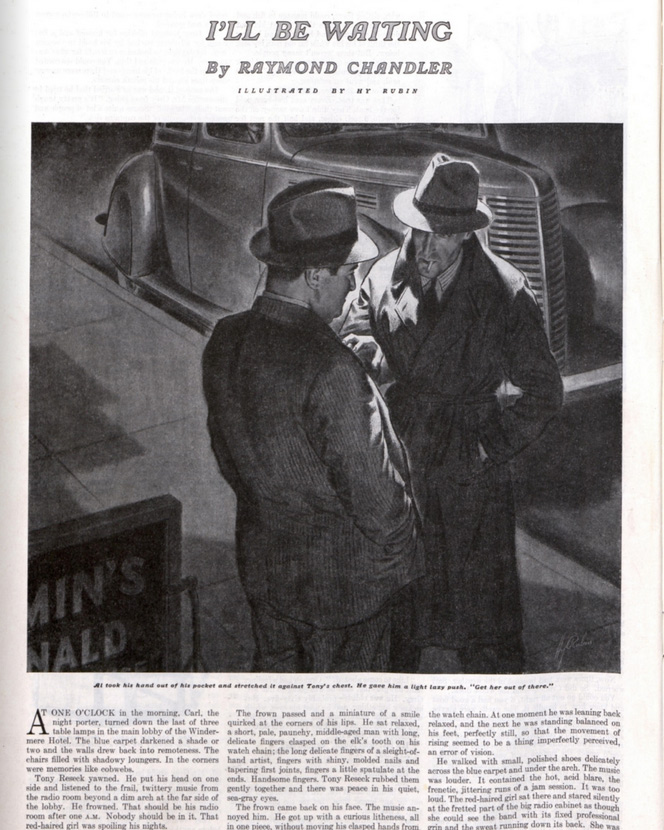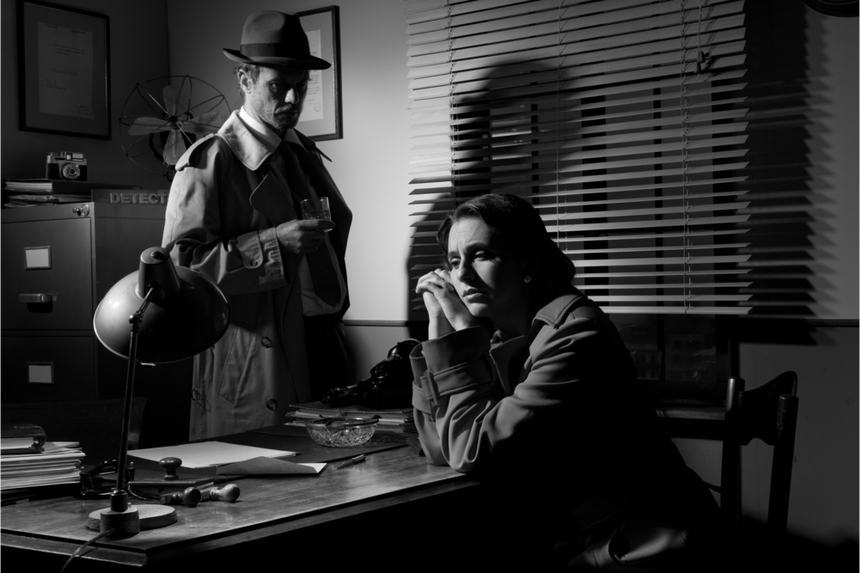Raymond Chandler didn’t invent hard-boiled detective fiction, but he certainly helped perfect it. Following in the footsteps of Gordon Young, Carroll John Daly and Dashiell Hammett, writers like Chandler and James M. Cain carved out a genre that would launch film noir at the movies and cement the idea of the two-fisted, gun-toting private eye as a staple of American culture. In 1939, just before he turned 51, Chandler published his first novel in that style, The Big Sleep; it introduced his character Philip Marlowe to a wider audience and set off a chain of film, radio, and stage adaptations. Today, the novel is regarded by publications like Time and Le Monde as one of the best books of the 20th Century. Today, we look back at The Big Sleep, Chandler, and the 1939 short story that he contributed to The Saturday Evening Post.
While the detective genre is widely considered to have begun with Edgar Allan Poe’s “The Murders in the Rue Morgue” in 1841, variations, some subtle and some not, began to appear almost immediately. Sir Arthur Conan Doyle’s Sherlock Holmes stories followed a few decades later, and various writers indulged in a number of mannered, even high-class, tales of crime-solving. Then came Black Mask magazine in 1920.
Over time and under a variety of editors, Black Mask ran stories by writers that broke new ground in detective fiction, westerns, and more, upping the ante by allowing longer pieces that were able to include more sophisticated plots and heretofore unseen levels of sex and violence. Dozens of male and female writers who appeared in those pages went on to greater fame; Chandler published 11 stories there between December 1933 and January 1937. That included the October 1934 story “Finger Man,” which introduced the character that Chandler would later transform into his ongoing protagonist, Philip Marlowe.
Chandler had done a lot of living before he turned his hand to detective fiction. Born in Chicago, he was raised and educated in England. He taught part-time while working as a writer and a reporter. Chandler eventually moved back to the States, living in Los Angeles and studying to be an accountant. During World War I, he was one of many Americans to join the Canadian Expeditionary Force. Chandler fought in France, was wounded, and received flight training with the Royal Air Force before the close of the war. Back in the U.S., he worked for an oil company until 1932, but he was dismissed for a combination of factors, including heavy drinking, depression, missed work, and general womanizing. In 1933, he sold his first hard-boiled story to Black Mask, “Blackmailers Don’t Shoot.”
By 1939, Chandler turned out his first novel. A synthesis of his short stories “Killer in the Rain” and “The Curtain,” The Big Sleep combined similar elements into a new narrative featuring private investigator Philip Marlowe. Marlowe displays the hard-drinking, wiseass persona that culture has come to associate with the P.I. archetype, but he’s markedly intelligent, operates with a moral code, and plays chess, often against himself. That slightly cultured aspect, reflective of Chandler’s own English upbringing, sets Marlowe apart from the crowd and positions him as a wittier protagonist when it comes to dealing with the rich and powerful who get in his way.
The original trailer for the 1946 adaptation of The Big Sleep. (Uploaded to YouTube by Movieclips Classic Trailers)
The plot of The Big Sleep occasionally confuses readers because it’s complicated, but also because Chandler himself forgot to account for certain things as he stitched the story together from other parts. The most notorious example is that the murderer of the chauffeur is never revealed, a fact that, according to Hollywood legend, the writer never realized until the novel was being adapted into a film. However, the novel also deals with things that the 1946 film wasn’t allowed to address directly at the time, like the fact that the source of the blackmail material for Carmen Sternwood is pornographic photos or that Geiger and Lundgren had a homosexual relationship. For a number of observers, time and distance have melded the novel and the original film into a single entity in their minds, and they tend to forget the differences. There’s also a bit of “Mandela Effect” related to the story due to the fact that Humphrey Bogart played both Marlowe in The Big Sleep and Hammett’s similarly-garbed P.I. Sam Spade in the earlier adaptation of The Maltese Falcon. Film critics have even been known to confuse the two, leading to multiple attempts by critics to set the record straight.
The Big Sleep’s influence spread quickly. By the following year, Chandler had released his second Marlowe novel, Farewell, My Lovely; it would actually be the first of the novels to be adapted into film (as Murder, My Sweet), although The Big Sleep remains the better-known movie. Though contemporary critics were occasionally harsh on Chandler, as they were on most popular fiction, Chandler drew the admiration of other writers, like James Bond creator Ian Fleming. His colorful turns of phrase, such as “It was a blonde. A blonde to make a bishop kick a hole in a stained-glass window” from Farewell, My Lovely, added to his popularity; that style, combined with his first-person narration, have become indelibly associated with detective fiction.
Today, Chandler is recognized as one of the biggest figures in his field. All of the Marlowe novels (except Playback) have been adapted into films, many more than once. There have been Marlowe TV series and radio dramas. Additionally, Chandler’s literary analysis of detective fiction, The Simple Art of Murder, is regarded as a seminal text of the genre. Different types of crime stories come in and out of fashion, but Chandler’s characterizations, ambiance, and language show no signs of taking a sleep of any size.

Featured image: Shutterstock.
Become a Saturday Evening Post member and enjoy unlimited access. Subscribe now




Comments
Mr. Hill,
I have not seen your annotated version of The Big Sleep. I have two copies of the novel, one from a Vintage printing in the ’90s, one older. I did not lift anything from your work, as I’ve never seen it. I’m sorry that you feel that my writing was too similar to what you wrote, but I guarantee that this is more of an incident of what Alan Moore refers to as “ideaspace” than any malfeasance on my part. If I’m quoting something, I quote it.
Additionally, this isn’t the first time I’ve written about The Big Sleep and noir in general. I’ve written pieces that include some of my thoughts for Comicon.com’s The Pulse, Newsarama, and other sources going back more than sixteen years. Again, I’m sorry that you felt anything was taken from your work, but I’ve never seen it.
Thank you.
As co-editor of The Annotated Big Sleep (Vintage Crime, 2018) I was, to say the least, interested in this piece, but I was dismayed to see passages and phrasing lifted, in a not-quite-verbatim fashion, from our introduction and annotations. This would be flattering had our book been acknowledged, and if quoted passages had been, well, quoted.
And the screenplay was written by Jules Furthman, William Faulkner and Leigh Brackett. The latter was a science fiction writer as well as a screenwriter; her last project was the screenplay for “The Empire Strikes Back.” The film was dedicated to her memory.